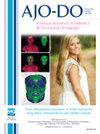三维打印正畸托槽剪切粘结强度的研究
IF 3
2区 医学
Q1 DENTISTRY, ORAL SURGERY & MEDICINE
American Journal of Orthodontics and Dentofacial Orthopedics
Pub Date : 2025-08-28
DOI:10.1016/j.ajodo.2025.03.008
引用次数: 0
摘要
摘要本研究旨在评价3种不同基托设计的三维打印正畸托槽的剪切粘结强度(SBS)和粘接剂残留指数(ARI),并利用扫描电镜(SEM)观察剩余粘接剂的表面形态差异。方法将60颗上颌前磨牙(每组20颗)随机分为3个托基设计组:(1)定制组、(2)大固位组和(3)标准组。在对牙齿进行数字扫描后,使用MAX UV DLP 3D打印机(Asiga, Sydney, Australia)打印支架。每个支架使用Transbond XT复合材料粘合,并使用发光二极管固化装置(Valo; Ultradent, South Jordan, Utah)光固化10秒。随后,在通用试验机上以1 mm/min的十字头速度进行SBS测试,并以兆帕卡(MPa)为单位记录断裂载荷。脱粘后,由盲法研究者在数码显微镜下评估ARI评分,并在2周后重新评估其可靠性。此外,在高分辨率扫描电镜(30 kV, 20 mm工作距离)下检查支架底座和齿面。结果SBS最高的是定制基架设计组(A组,8.05±4.69 MPa),其次是大固位组(B组,6.31±3.80 MPa)和标准组(C组,5.91±6.09 MPa)。A组与C组比较,差异有统计学意义(P = 0.017)。ARI评分显示,在A组和B组中,大多数粘接剂保留在牙齿上(ARI评分为2分),而C组显示出更多的ARI分布变化。此外,从扫描电镜的结果来看,所有组的大部分粘接剂都保留在牙齿上。结论3d打印正畸托槽的定制补片设计显著提高了粘接强度和粘接剂固着性,是临床应用的理想选择。未来的研究应进一步考察其在模拟口腔环境条件下的性能,以验证其临床适用性。本文章由计算机程序翻译,如有差异,请以英文原文为准。
Shear bond strength of 3-dimensional-printed orthodontic brackets
Introduction
This in vitro study aimed to evaluate the shear bond strength (SBS) and adhesive remnant index (ARI) of 3-dimensional-printed orthodontic brackets with 3 different base designs and to examine the surface morphologic differences of remaining adhesives using scanning electron microscopy (SEM).
Methods
Sixty maxillary premolar teeth (n = 20 per group) were randomly allocated into 3 bracket base design groups: (1) custom, (2) macroretentive, and (3) standard. After digital scanning of the teeth, the brackets were printed using a MAX UV DLP 3D printer (Asiga, Sydney, Australia). Each bracket was bonded using Transbond XT composite and light-cured for 10 seconds with a light-emitting diode curing unit (Valo; Ultradent, South Jordan, Utah). Subsequently, SBS testing was performed using a universal testing machine at a 1 mm/min crosshead speed, and fracture loads were recorded in megapascals (MPa). After debonding, ARI scores were evaluated under a digital microscope by a blinded investigator and reevaluated after 2 weeks for reliability. In addition, bracket bases and tooth surfaces were examined under a high-resolution SEM (30 kV, 20 mm working distance).
Results
The highest SBS values were observed in the custom base design group (group A, 8.05 ± 4.69 MPa), followed by the macroretentive group (group B, 6.31 ± 3.80 MPa) and the standard group (group C, 5.91 ± 6.09 MPa). The differences between groups A and C were statistically significant (P = 0.017). ARI scores revealed that in groups A and B, most adhesive remained on the tooth (ARI score 2 predominated), whereas group C demonstrated a more variable ARI distribution. In addition, according to the SEM results, most adhesives have remained on the teeth in all groups.
Conclusions
Custom mesh designs in 3D-printed orthodontic brackets significantly enhance bond strength and adhesive retention, making them a promising option for clinical use. Future studies should investigate their performance under conditions that simulate the oral environment to validate their clinical applicability.
求助全文
通过发布文献求助,成功后即可免费获取论文全文。
去求助
来源期刊
CiteScore
4.80
自引率
13.30%
发文量
432
审稿时长
66 days
期刊介绍:
Published for more than 100 years, the American Journal of Orthodontics and Dentofacial Orthopedics remains the leading orthodontic resource. It is the official publication of the American Association of Orthodontists, its constituent societies, the American Board of Orthodontics, and the College of Diplomates of the American Board of Orthodontics. Each month its readers have access to original peer-reviewed articles that examine all phases of orthodontic treatment. Illustrated throughout, the publication includes tables, color photographs, and statistical data. Coverage includes successful diagnostic procedures, imaging techniques, bracket and archwire materials, extraction and impaction concerns, orthognathic surgery, TMJ disorders, removable appliances, and adult therapy.

 求助内容:
求助内容: 应助结果提醒方式:
应助结果提醒方式:


